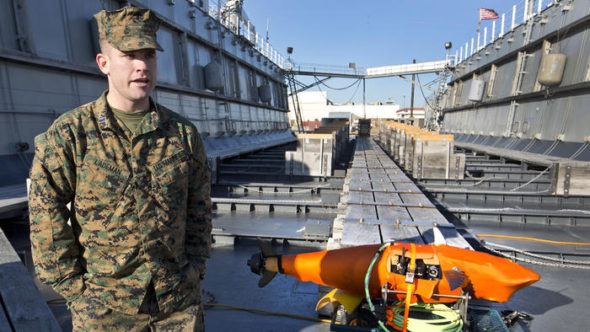Navy testing ‘spy fish’ based on bluefin tuna
Daily News Article — Posted on December 18, 2014

USMC Capt. Jerry Lademan with one of the two Swimmer Devices. Project Silent Nemo is exploring the possible uses of Ghost Swimmer; a biomimetic device developed by the Office of Naval Research and made by Boston Engineering.
(by Husna Haq, CS Monitor) – The US Navy is developing a a robotic fish drone for spying operations that may soon be able to swim unmanned, collecting intelligence and accessing forbidden areas. Project Silent Nemo – named after the Disney movie about a clown fish – has cost about $1 million so far and could be operational as early as next year.
Codenamed “Ghostswimmer,” the 5-foot, 100-pound unmanned underwater vehicle [UUV] swims and behaves just like a bluefin tuna fish (although it has a dorsal fin like a shark), waving its tail back and forth to propel itself. The prototype can reach speeds up to 40 knots, or about 46 mph, and depths up to 300 feet.
On Dec. 11, the robotic fish took a test swim, gliding through the waters at Joint Expeditionary Base Little Creek controlled by a joystick. It can also be set to swim automatically, on its own.
The beauty of Robo-tuna, as it is affectionately called, is that it’s modeled after the best bio-engineering on earth: nature.
“This is part of a new field of underwater unmanned vehicles that use biomimicry,” project lead Marine Corps Capt. Jerry Lademan told Mashable. …
In order to develop Project Nemo, US Navy engineers “reverse-engineered” the way a tuna fish moves.
Robo-tuna’s secret: It moves like a fish, not a submersible. By mimicking the natural swimming motion of a fish rather than a typical propeller-driven torpedo-shaped drone, the tuna fish drone moves extremely quietly, can make tight turns, and is virtually undetectable. That means it can sneak into enemy waters and collect information or deliver payloads more effectively.
“The tuna fish is one of the few aquatic animals that uses just half its body to propel itself forward,” Capt. Lademan said. “With most fish, the whole body is involved. So the biology of it makes sense for an unmanned underwater vehicle, because it’s much easier to design a UUV where only the back half moves.”
Once operational, Ghostswimmer may be sent on intelligence, surveillance and reconnaissance missions, where, reports the Daily Press, “[I]t could be used to inspect the hull of a ship, check waters for threats such as mines or protrusions, deliver payloads including sonar and guidance packages, and access otherwise denied areas.”
Weaponry has not yet been tested for Operation Nemo. But as Christopher Harmer, senior naval analyst with the Institute for the Study of War, told The Christian Science Monitor: “There isn’t any ground-breaking technology that the military hasn’t found some way to eventually weaponize.”
Reprinted here for educational purposes only. May not be reproduced on other websites without permission from The Christian Science Monitor. Visit the website at csmonitor .com.
Questions
1. The first paragraph of a news article should answer the questions who, what, where and when. List the who, what, where and when of this news item. (NOTE: The remainder of a news article provides details on the why and/or how.)
2. How is the Ghostswimmer controlled?
3. For what purposes is the Ghostswimmer used?
4. Why is Nemo modeled after the tuna fish specifically?
5. What are the advantages of modeling this UUV after a fish over the typical propeller-driven torpedo-shaped drone?
6. What potential addition to the Ghostswimmer drone has not yet been tested?
7. How does this project inspire you?
Background
- Nemo was developed by the Office of Naval Research and is being tested by the chief of naval operation's Rapid Innovation Cell - a group of junior Navy and Marine Corps officers tasked with putting emerging technologies to use for the military. The same group has been playing around with 3D printers, augmented-reality glasses and about 10 other breakthrough gadgets.
- The idea of deploying robots that mimic the biological traits of living creatures isn't new, but until recently, it existed mostly in the realm of science fiction. The Navy says Silent Nemo - also known as GhostSwimmer - could be operational within the next year.
- Typical unmanned underwater vehicles are torpedo-shaped and propeller-driven. The natural swimming motion of a fish makes far less noise and is more difficult to detect with sonar devices.
- "The first time I saw it, I thought it was a living fish," Jerry Lademan, a 27-year-old Marine captain who's leading the project said. "It looks alive. It's crazy."
- The Navy envisions deploying a fleet of robotic fish to patrol harbors or swim into hostile territory. Nemo could be used to search for sea mines or inspect ship hulls for damage - two critical tasks that often put humans in harm's way. (from The Virginia Pilot)
===
- The U.S. Navy is calling the project “Silent NEMO” and the unmanned underwater vehicle (UUV) is known as “GhostSwimmer.” It’s being developed at the Joint Expeditionary Base Little Creek in Virginia Beach.
- The undersea vehicle is about 5 feet long and weights about 100 pounds. It can be controlled by a joystick or it can be preprogrammed to move on its own.
- It was created by the Chief of Naval Operations Rapid Innovation Cell (CRIC), a unit that develops commercial technologies for military use, in conjunction with Boston Engineering.
- Because it looks like a fish and swims like a fish, the Navy believes it will easily evade sophisticated sonar.
- The Navy thinks it might be useful for three things: swimming in hostile waters, searching for destructive underwater mines, or to looking for underwater damage. Saving lives by doing dangerous underwater tasks that might otherwise be done by humans. (from CNN)
